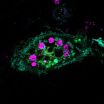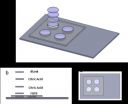(Press-News.org) Over the years, computer chips have gotten smaller thanks to advances in materials science and manufacturing technologies. This march of progress, the doubling of transistors on a microprocessor roughly every two years, is called Moore's Law. But there's one component of the chip-making process in need of an overhaul if Moore's law is to continue: the chemical mixture called photoresist. Similar to film used in photography, photoresist, also just called resist, is used to lay down the patterns of ever-shrinking lines and features on a chip.
Now, in a bid to continue decreasing transistor size while increasing computation and energy efficiency, chip-maker Intel has partnered with researchers from the U.S. Department of Energy's Lawrence Berkeley National Lab (Berkeley Lab) to design an entirely new kind of resist. And importantly, they have done so by characterizing the chemistry of photoresist, crucial to further improve performance in a systematic way. The researchers believe their results could be easily incorporated by companies that make resist, and find their way into manufacturing lines as early as 2017.
The new resist effectively combines the material properties of two pre-existing kinds of resist, achieving the characteristics needed to make smaller features for microprocessors, which include better light sensitivity and mechanical stability, says Paul Ashby, staff scientist at Berkeley Lab's Molecular Foundry, a DOE Office of Science user facility. "We discovered that mixing chemical groups, including cross linkers and a particular type of ester, could improve the resist's performance." The work is published this week in the journal Nanotechnology.
Finding a new kind of photoresist is "one of the largest challenges facing the semiconductor industry in the materials space," says Patrick Naulleau, director of the Center for X-ray Optics (CXRO) at Berkeley Lab.
Moreover, there's been very little understanding of the fundamental science of how resist actually works at the chemical level, says Deirdre Olynick, staff scientist at the Molecular Foundry. "Resist is a very complex mixture of materials and it took so long to develop the technology that making huge leaps away from what's already known has been seen as too risky," she says. But now the lack of fundamental understanding could potentially put Moore's Law in jeopardy, she adds.
To understand why resist is so important, consider a simplified explanation of how your microprocessors are made. A silicon wafer, about a foot in diameter, is cleaned and coated with a layer of photoresist. Next ultraviolet light is used to project an image of the desired circuit pattern including components such as wires and transistors on the wafer, chemically altering the resist.
Depending on the type of resist, light either makes it more or less soluble, so when the wafer is immersed in a solvent, the exposed or unexposed areas wash away. The resist protects the material that makes up transistors and wires from being etched away and can allow the material to be selectively deposited. This process of exposure, rinse and etch or deposition is repeated many times until all the components of a chip have been created.
The problem with today's resist, however, is that it was originally developed for light sources that emit so-called deep ultraviolet light with wavelengths of 248 and 193 nanometers. But to gain finer features on chips, the industry intends to switch to a new light source with a shorter wavelength of just 13.5 nanometers. Called extreme ultraviolet (EUV), this light source has already found its way into manufacturing pilot lines. Unfortunately, today's photoresist isn't yet ready for high volume manufacturing.
"The semiconductor industry wants to go to smaller and smaller features," explains Ashby. While extreme ultraviolet light is a promising technology, he adds, "you also need the resist materials that can pattern to the resolution that extreme ultraviolet can promise."
So teams led by Ashby and Olynick, which include Berkeley Lab postdoctoral researcher Prashant Kulshreshtha, investigated two types of resist. One is called crosslinking, composed of molecules that form bonds when exposed to ultraviolet light. This kind of resist has good mechanical stability and doesn't distort during development—that is, tall, thin lines made with it don't collapse. But if this is achieved with excessive crosslinking, it requires long, expensive exposures. The second kind of resist is highly sensitive, yet doesn't have the mechanical stability.
When the researchers combined these two types of resist in various concentrations, they found they were able to retain the best properties of both. The materials were tested using the unique EUV patterning capabilities at the CXRO. Using the Nanofabrication and Imaging and Manipulation facilities at the Molecular Foundry to analyze the patterns, the researchers saw improvements in the smoothness of lines created by the photoresist, even as they shrunk the width. Through chemical analysis, they were also able to see how various concentrations of additives affected the cross-linking mechanism and resulting stability and sensitivity.
The researchers say future work includes further optimizing the resist's chemical formula for the extremely small components required for tomorrow's microprocessors. The semiconductor industry is currently locking down its manufacturing processes for chips at the so-called 10-nanometer node. If all goes well, these resist materials could play an important role in the process and help Moore's Law persist.
INFORMATION:
This research was funded by the Intel Corporation, JSR Micro, and the DOE Office of Science (Basic Energy Sciences).
Lawrence Berkeley National Laboratory addresses the world's most urgent scientific challenges by advancing sustainable energy, protecting human health, creating new materials, and revealing the origin and fate of the universe. Founded in 1931, Berkeley Lab's scientific expertise has been recognized with 13 Nobel prizes. The University of California manages Berkeley Lab for the U.S. Department of Energy's Office of Science. For more, visit http://www.lbl.gov.
For over a decade Berkeley Lab's Center for X-Ray Optics has conducted photolithography-related research, including world-leading programs in optics, masks, and materials — most conducted on three CXRO beamlines at the Advanced Light Source. For more information on CXRO, visit http://www.cxro.lbl.gov. For more information about the Advanced light source, visit http://www.als.lbl.gov.
The Molecular Foundry is one of five DOE Nanoscale Science Research Centers (NSRCs), national user facilities for interdisciplinary research at the nanoscale, supported by the DOE Office of Science. Together the NSRCs comprise a suite of complementary facilities that provide researchers with state-of-the-art capabilities to fabricate, process, characterize and model nanoscale materials, and constitute the largest infrastructure investment of the National Nanotechnology Initiative. The NSRCs are located at DOE's Argonne, Brookhaven, Lawrence Berkeley, Oak Ridge and Sandia and Los Alamos National Laboratories. For more information about the DOE NSRCs, please visit http://science.energy.gov. For more information about the Molecular Foundry, visit http://foundry.lbl.gov/.
Fundamental chemistry findings could help extend Moore's Law
A Berkeley Lab-Intel collaboration outlines the chemistry of photoresist, enabling smaller features for future generations of microprocessors
2014-07-15
ELSE PRESS RELEASES FROM THIS DATE:
Study: Body Dysmorphic Disorder patients have higher risk of personal and appearance-based rejection sensitivity
2014-07-15
PROVIDENCE, R.I. – In a recent study, researchers at Rhode Island Hospital found that fear of being rejected because of one's appearance, as well as rejection sensitivity to general interpersonal situations, were significantly elevated in individuals with Body Dysmorphic Disorder (BDD). These fears, referred to as personal rejection sensitivity and appearance-based rejection sensitivity, can lead to diminished quality of life and poorer mental and overall health. BDD is a common, often severe, and under-recognized body image disorder that affects an estimated 1.7 to 2.4 ...
Prostate cancer in young men -- More frequent and more aggressive?
2014-07-15
ANN ARBOR, Mich. -- The number of younger men diagnosed with prostate cancer has increased nearly 6-fold in the last 20 years, and the disease is more likely to be aggressive in these younger men, according to a new analysis from researchers at the University of Michigan Comprehensive Cancer Center.
Typically, prostate cancer occurs more frequently as men age into their 70s or 80s. Many prostate cancers are slow-growing and many older men diagnosed with early stage prostate cancer will end up dying from causes other than prostate cancer.
But, the researchers found, ...
Rollout strategy for diagnostic test in India may impact TB
2014-07-15
Xpert MTB/RIF, a recently implemented tuberculosis (TB) test, has the potential to control the TB epidemic in India, but only if the current, narrow, implementation strategy is replaced by a more ambitious one that is better funded, also includes the private sector, and better referral networks are developed between public and private sectors, according to new research published in this week's PLOS Medicine. The study by David Dowdy, from Johns Hopkins University, United States, and colleagues is a mathematical model that suggests alternative strategies that include engagement ...
Molecular 'eat now' signal makes cells devour dying neighbors
2014-07-15
A team of researchers has devised a Pac-Man-style power pellet that gets normally mild-mannered cells to gobble up their undesirable neighbors. The development may point the way to therapies that enlist patients' own cells to better fend off infection and even cancer, the researchers say.
A description of the work will be published July 15 in the journal Science Signaling.
"Our goal is to build artificial cells programmed to eat up dangerous junk in the body, which could be anything from bacteria to the amyloid-beta plaques that cause Alzheimer's to the body's own ...
Neurons, brain cancer cells require the same little-known protein for long-term survival
2014-07-15
CHAPEL HILL, N.C. – Researchers at the UNC School of Medicine have discovered that the protein PARC/CUL9 helps neurons and brain cancer cells override the biochemical mechanisms that lead to cell death in most other cells. In neurons, long-term survival allows for proper brain function as we age. In brain cancer cells, though, long-term survival contributes to tumor growth and the spread of the disease.
These results, published in the journal Science Signaling, not only identify a previously unknown mechanism used by neurons for their much-needed survival, but show that ...
Rollout strategy is key to battling India's TB epidemic, researchers find
2014-07-15
A new study led by Johns Hopkins Bloomberg School of Public Health researchers suggests that getting patients in India quickly evaluated by the right doctors can be just as effective at curbing tuberculosis (TB) as a new, highly accurate screening test.
While ideally all suspected TB cases would be evaluated with the new test, it is primarily being used only on the highest-risk populations and only in public health clinics, partly because of its cost and the complexity of the nation's health care system. This slows diagnosis of a disease that must be caught early, the ...
New assay to spot fake malaria drugs could save thousands of lives
2014-07-15
CORVALLIS, Ore. – Chemists and students in science and engineering at Oregon State University have created a new type of chemical test, or assay, that's inexpensive, simple, and can tell whether or not one of the primary drugs being used to treat malaria is genuine – an enormous and deadly problem in the developing world.
The World Health Organization has estimated that about 200,000 lives a year may be lost due to the use of counterfeit anti-malarial drugs. When commercialized, the new OSU technology may be able to help address that problem by testing drugs for efficacy ...
3-D nanostructure could benefit nanoelectronics, gas storage
2014-07-15
A three-dimensional porous nanostructure would have a balance of strength, toughness and ability to transfer heat that could benefit nanoelectronics, gas storage and composite materials that perform multiple functions, according to engineers at Rice University.
The researchers made this prediction by using computer simulations to create a series of 3-D prototypes with boron nitride, a chemical compound made of boron and nitrogen atoms. Their findings were published online July 14 in the Journal of Physical Chemistry C.
The 3-D prototypes fuse one-dimensional boron nitride ...
TGen-led study finds likely origin of lung fungus invading Pacific Northwest
2014-07-15
FLAGSTAFF, Ariz. - Cryptococcus gattii, a virulent fungus that has invaded the Pacific Northwest is highly adaptive and warrants global "public health vigilance," according to a study by an international team led by the Translational Genomics Research Institute (TGen).
C. gattii, which likely originated in Brazil, is responsible for dozens of deaths in recent years since it was first found in 1999 on Vancouver Island, British Columbia, Canada, well outside its usual tropical habitats.
"We identified several genes that may make the outbreak strains more capable of surviving ...
Rice nanophotonics experts create powerful molecular sensor
2014-07-15
Nanophotonics experts at Rice University have created a unique sensor that amplifies the optical signature of molecules by about 100 billion times. Newly published tests found the device could accurately identify the composition and structure of individual molecules containing fewer than 20 atoms.
The new imaging method, which is described this week in the journal Nature Communications, uses a form of Raman spectroscopy in combination with an intricate but mass reproducible optical amplifier. Researchers at Rice's Laboratory for Nanophotonics (LANP) said the single-molecule ...
LAST 30 PRESS RELEASES:
Itaconate modifications: mechanisms and applications
Potential tumor-suppressing gene identified in pancreatic cancer
Winners of the 2026 Hill Prizes announced
Autonomous AI agents developed to detect early signs of cognitive decline
Study finds ocean impacts nearly double economic cost of climate change
Increased deciduous tree dominance reduces wildfire carbon losses in boreal forests
Researchers discover how a respiratory bacterium obtains essential lipids from the human body and targets fat-rich tissues
Locust swarms destroy crops. Scientists found a way to stop that
More resources and collaboration needed to support prevention and treatment of obesity
Two types of underconfidence linked to anxiety and gender
Insects are victims too: Global study shows impacts of invasive alien species on populations
Pioneering natural, degradable polymer capsules
Forestry is becoming digital and automated
Maternity baby deaths much higher in northern England than in the South
Mosquitoes’ thirst for human blood has increased as biodiversity loss worsens
The stop-smoking medication varenicline may also work for cannabis use disorder
Potential new treatment for sepsis
Study reveals how many hours of video games per week might be too many
Electrospinning for mimicking bioelectric microenvironment in tissue regeneration
Home fingertip oxygen monitors less accurate for people with darker skin tones
Six weeks in a cast no less effective than surgery for unstable ankle fractures
Precautionary approach to alcohol-free and low alcohol drinks needed to protect public health, say experts
Gas-atomized Ca–Mg alloy powders produce hydrogen simply by adding water — high-efficiency hydrogen generation at room temperature
British redcoat’s lost memoir reveals harsh realities of life as a disabled veteran
World-leading rare earth magnet recycling facility launches in UK
Corday Selden selected for the Oceanography Society Early Career Award
MIT chemists determine the structure of the fuzzy coat that surrounds Tau proteins
Same moves, different terrain: How bacteria navigate complex environments without changing their playbook
Severe weather is deadly for vulnerable older adults long after the storm ends, study finds
Expert panel highlights opportunities for improving cancer studies
[Press-News.org] Fundamental chemistry findings could help extend Moore's LawA Berkeley Lab-Intel collaboration outlines the chemistry of photoresist, enabling smaller features for future generations of microprocessors





